Data published in the Walking and Cycling Index has identified that LGBTQ+ people feel less safe in their neighbourhoods than cisgender and heterosexual people. In this blog, Graham Read, founding member of Sustrans Progress Pride Network and our Graphic Design Manager, delves into evidence to explore this issue and asks what can be done to change this unacceptable state.
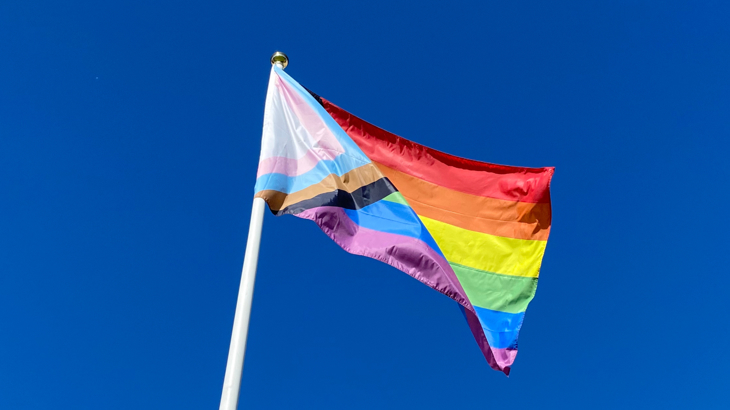
Photo: Graham Read/Sustrans
The Walking and Cycling Index is the largest survey of walking, wheeling and cycling in 18 urban areas across the UK and Ireland.
It not only analyses how and why residents travel but also how safe they feel in their neighbourhoods.
Because our safety and perceptions of safety strongly influence how we choose to travel.
When I first read the results of the Walking and Cycling Index, I wasn’t surprised that LGBTQ+ people feel less safe, less welcome and less comfortable in their neighbourhoods and cities than cisgender and heterosexual people.
This has often been my own experience.
Meanwhile, abuse, harassment and hate crimes directed at LGBTQIA+ people, people of colour, women and disabled people are rising.
We all want to feel safe in our communities.
To live in fear of persecution or attack is unacceptable.
Especially in a place where we should feel safe, our own neighbourhood.
We can all play a part in creating this feeling of safety by ensuring others feel welcome and comfortable.
In addition, transport professionals, urban designers, town planners and local authority decision-makers have a particularly important role to play when designing our public spaces.
About the use of LGBTQIA+ and other acronyms
In this blog I use the acronym LGBTQIA+ to represent lesbian, gay, bisexual, pansexual, trans, queer, questioning, intersex and asexual people.
When the acronym varies from this, it’s because it’s reflecting the categorisations which were used in the relevant research.
For example, in the Walking and Cycling Index, sexuality and gender data were separated, so sexuality data ‘LGBQ+’ is differentiated from data based on gender.
Recognising intersectionality to understand individual experiences
When looking into how safe LGBTQIA+ people feel in their neighbourhoods, it’s important to recognise that as a community, we are diverse.
As such, our experiences will differ.
As well as identifying as lesbian, gay, bisexual, pansexual, trans, intersex, queer, questioning or asexual, we’ll also identify with other characteristics protected under the Equality Act 2010.
For example, a Black lesbian woman may experience layers of oppression and discrimination including racism, homophobia and misogyny.
This is known as intersectionality because an individual’s unique experience exists at the intersection of any number of different characteristics.
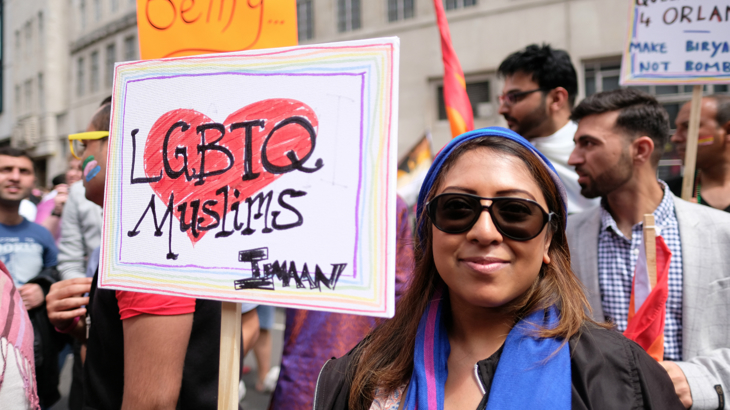
Photo: 'LGBTQ Muslims - one of several Muslim participators in London's LGBT Pride Parade - 25 June 2016' by alisdare1 is licensed under CC BY-NC 2.0. To view a copy of this license, visit https://creativecommons.org/licenses/by-nc/2.0/?ref=openverse.
Shocking rates of abuse, harassment and hate crime
In our research for the Walking and Cycling Index 2021, we surveyed over 24,000 people in urban areas of the UK and Ireland.
We learned that only 51% of people who identified their gender ‘in another way’ feel welcome and comfortable walking or spending time on the streets of their neighbourhood, compared to 65% of women and 67% of men.
59% of LGBQ+ people feel welcome and comfortable walking or spending time on the streets in their neighbourhood, compared to 67% of heterosexual people.
That’s just over half of people who are trans, non-binary or who identify their gender in another way, feeling welcome and comfortable in their own neighbourhoods.
I think that’s disgraceful.
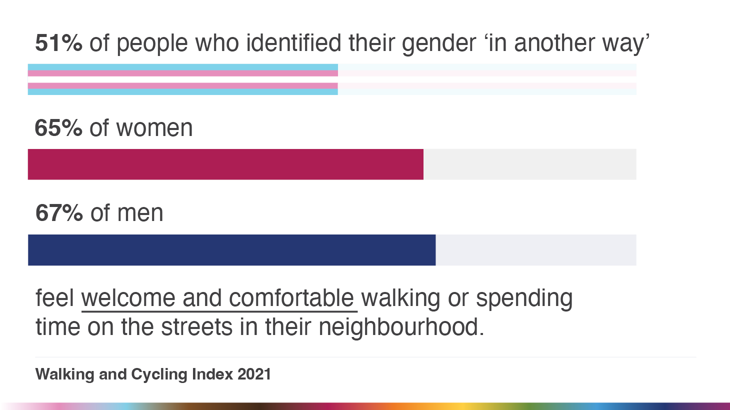
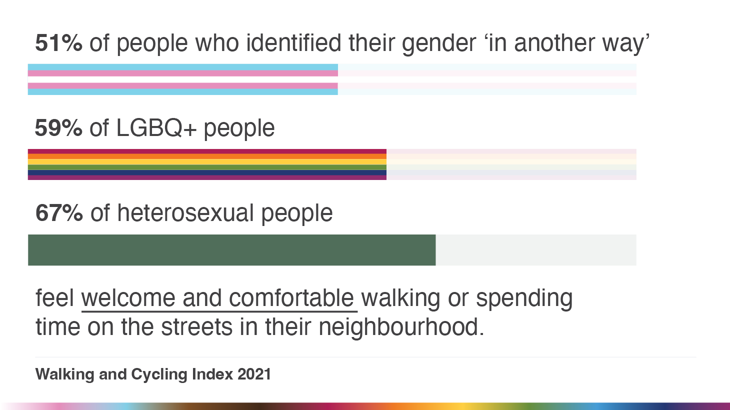
Moreover, just 60% of people who identified their gender ‘in another way’ think walking safety (including personal safety) is good, compared to 68% of women and 70% of men.
65% of LGBQ+ people think walking safety (including personal safety) is good, compared to 69% of heterosexual people.
So why do LGBTQIA+ people feel less safe?
For many LGBTQIA+ people harassment is a commonplace experience.
From 2018/19 to 2019/20 the following hate crimes dramatically increased:
- sexual orientation hate crimes increased by 19%
- transgender identity hate crimes increased by 16%
- disability hate crimes increased by 9%.
In the 12 months prior to this report being published in 2018, 53% of trans people aged 18-24 and 41% of trans people of all ages, have experienced a hate crime or incident based on their gender identity.
And 44% of trans people avoid certain streets altogether because they don’t feel safe there as an LGBT person [IBID].
Therefore it’s not surprising that recent evidence has shown that LGBTQ+ people are more likely to experience poorer mental and physical health outcomes than heterosexual people.
There is also strong evidence suggesting LGBTQ+ people in the UK have higher levels of stress, anxiety and depression.
Research indicates that poorer health outcomes may be connected to the long-term stress associated with an LGBTQ+ identity, including experiences of homo/bi/transphobia, stigmatisation and social isolation.
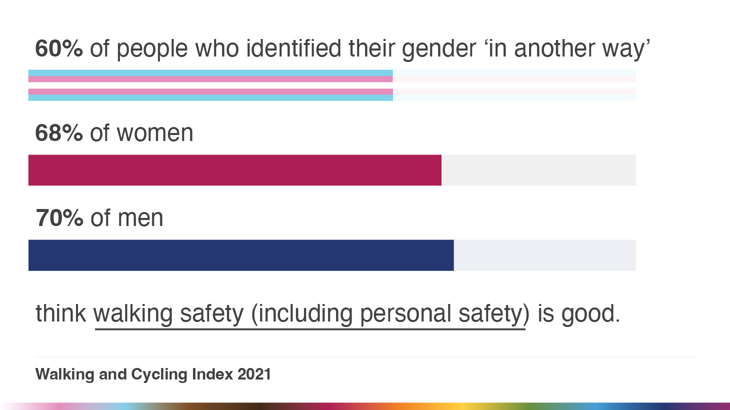
Thinking again about intersectionality, it’s important to see the wider context of abuse, harassment and hate crimes in the UK.
Studies show that women experience disproportionate levels of harassment in public spaces, including sexual harassment, compared to men.
On top of that, according to Home Office data, 74% of the hate crimes recorded by the police in England and Wales between March 2020 and March 2021 were motivated by race or racism.
This is just the tip of the iceberg.
People can experience many different layers of abuse, harassment and hate crimes.
All are unacceptable and action needs to be taken.
Code-switching to blend in
According to Arup and the University of Westminster’s Queering Public Space report:
‘LGBTQ+ people ‘switch’ or hide their identities in order to feel safe in the majority of public spaces.’
As LGBTQIA+ people, we’re used to hiding parts of ourselves.
We’re used to modifying our voices, behaving, dressing and even walking differently so that we blend in and don’t become a target for abuse.
This has become known as code-switching.
We’re often hyper-aware of ourselves, our environment and the people around us.
Checking who could be a threat.
Checking who’s nearby to help us if we are attacked or harassed.
Checking for escape routes.
I’ve heard this perpetual state of awareness referred to as ‘constantly risk assessing’.
This will also feel all too familiar for women, people who are disabled, people of a minoritised ethnicity, refugees, and people at the intersections of these identities.
Attitudes are gradually changing and there has been progress.
But every attack, every hate crime and every incident of abuse or harassment is one too many.
I’ve had slurs shouted at me on the street and even a drink thrown from a passing car.
I am a white cisgender man, my experience is a drop in the ocean compared to what others experience on a regular basis.
Read more about how some women respond to being outdoors and alone after dark.
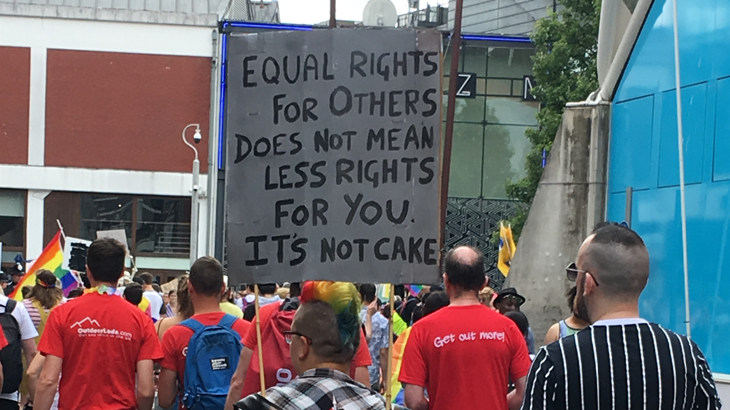
Photo: Graham Read/Sustrans
Seeking solutions to enable LGBTQIA+ people to feel safer
Making our streets safer can often be associated with increased police presence.
But 79% of trans people don't report hate crimes because they don’t feel supported or experience further discrimination.
Trust in the police is also lower amongst many other demographic groups, including women, people from the LGBTQIA+ community, disabled people, and people from Black and Mixed ethnicity groups.
So perhaps making physical changes to public spaces would help?
The Queering Public Space report from Arup and the University of Westminster recommends ‘designing in’ LGBTQIA+ inclusion in the planning of public spaces.
This could be through consulting with communities, including LGBTQIA+ people, so that insight into the possible impact of plans can be gained before work is signed off.
The report also recommends preserving and recognising LGBTQIA+ heritage in public spaces.
Read about LGBT+ people who have made it easier for us all to walk, wheel and cycle.
The design process of a public space considers many different elements, including (but certainly not limited to):
- Lighting: Where will it be? What type? How bright? Will it be on a timer?
- Seating: What style? Who is it suitable for?
- Lines of sight: How far can be seen? Will lighting change this?
- Accessibility: Who will have access? Who will struggle?
Sustrans’ own urban designers know that if they can get these elements right at the design stage, they can create safer spaces which will attract more people to walking, wheeling and cycling.
So how should we (along with any planner or designer in a local authority) get it right?
By asking LGBTQIA+ people: ‘What would make you feel safer?’
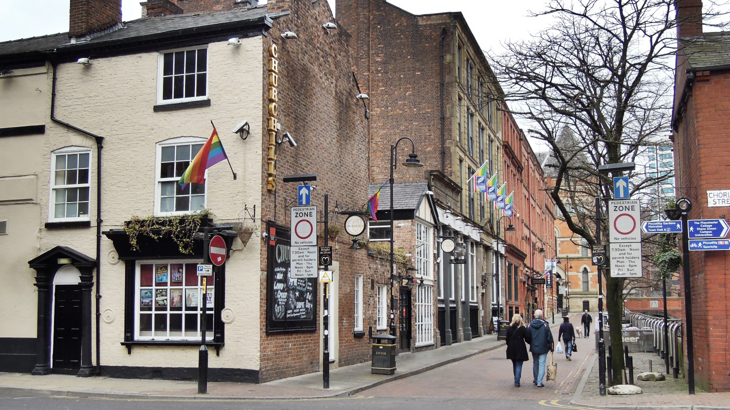
Canal Street in Manchester, pedestrianised and famous for its LGBTQIA+ bars and restaurants. Photo: 'Churchills, Canal Street, Manchester' by David McKelvey is licensed under CC BY-NC-ND 2.0. To view a copy of this license, visit https://creativecommons.org/licenses/by-nd-nc/2.0/jp/?ref=openverse.
Seeing people like us
Feeling welcome and safe in a place isn’t only determined by design.
Often it’s linked to whether we can see other people like us.
For instance, if I see visibly LGBTQIA+ couples holding hands somewhere, I’ll immediately feel safer and more able to do the same with my partner.
But I'm still constantly risk assessing the area and feeling vulnerable.
This is something many heterosexual couples probably take for granted.
Richard Hearne, Founder of PRiDE OUT, an LGBTQIA+ cycling group told me:
“Being in an LGBTQIA+ group like PRiDE OUT not only provides safety in numbers, it also creates community, connections, friendships and visibility.
“I set up PRiDE OUT to make friends, but we've also helped influence a culture change in cycling by being active, visible and vocal about the challenges in getting more LGBTQIA+ people cycling.”
I asked my LGBTQIA+ colleagues at Sustrans what helps them to feel safe in public spaces, one said:
“I need to know an area. Shockingly I still feel too self-conscious and expect negative attention otherwise.
“But if an area I don't know has some Progress Pride flags about, then I do feel more at ease.”
But Dr Ammar Azzouz co-author of Queering Public Space commented:
“We are living in times where we see the rainbow painted across different cities in the world.
“It is painted on benches, crossing points, chairs, walls and buses.
“Is this the only way that architects and planners can imagine how to ‘queer’ a place?
“What can we do to push the conversation beyond what has become to be known as rainbow washing?”
Flo Marshall, Principal Urban Designer for Sustrans South of England added:
“Public spaces in the UK have traditionally been designed for and by white heteronormative men.
“As such, those spaces work well for these individuals, but less so for everyone else.
“To change this and to challenge it, we need to involve local LGBTQIA+ people in the conversations, design processes and decisions which go into shaping our streets and public spaces.
“We need to listen, learn and enable the collaborative design of neighbourhoods and public spaces in a way which promotes inclusivity and respect.”
However, attitudes also need to change.
Another LGBTQIA+ colleague at Sustrans responded:
“[Because of past homophobic abuse] I don't feel that safe walking past pubs with groups of men (particularly older men) who are standing outside smoking, if there's women there as well, it's not so bad.”
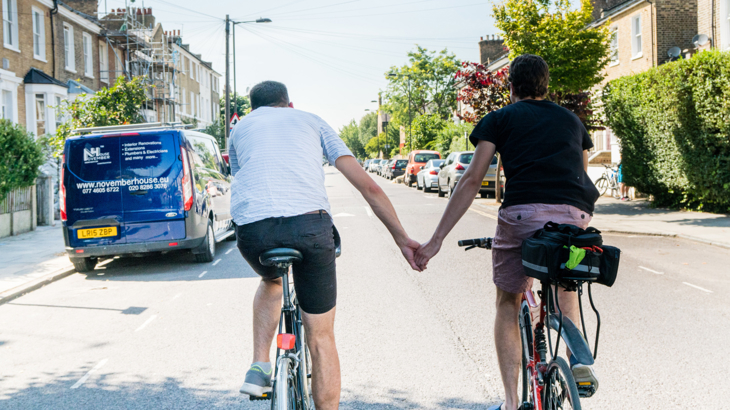
Photo: J Bewley/Sustrans
Creating better spaces for everyone
It seems to me that it’s not just about creating spaces and places that are LGBTQIA+ friendly.
Because spaces and places which are welcoming, comfortable and safe for LGBTQIA+ people will hopefully also be welcoming, safe and comfortable for women, disabled people, people of colour, and anyone who fears abuse or discrimination.
Alex Bottrill, Programme Lead for Urban Liveability at Sustrans summed it up well:
“There are places and situations that feel very easy to be in and others that are less so.
“The physical design of a place is influential in this regard.
“Until members of the LGBTQIA+ community like me feel that we can be ourselves and live our lives free of stigma, prejudice, discrimination or victimisation, all members of society have work to do.
“Everyone has a responsibility to affirm, support and strive to learn more about others, and to celebrate our differences.
“At Sustrans we challenge ourselves to make sure that we involve a range of people and perspectives in all our projects.
“We ensure that the people who we work with are representative of society, and that we amplify the needs of people who may have traditionally been overlooked.
“This helps us to design, deliver and inspire change that everyone will see the benefit of.”
Change is urgently needed
However well planned, changes to public spaces can be both hugely expensive to deliver and painfully slow to implement.
We can all immediately make a difference though, by striving to help LGBTQIA+ people like me feel more welcome, comfortable and safe.
For example, you could:
- challenge your friends, family, colleagues or acquaintances when discriminatory or dismissive comments are made
- invite and listen to the views of LGBTQIA+ people and accept their experiences, however uncomfortable this might be
- adjust your own behaviour in response to what you've learned through listening
- change the physical environments which you have control over.
Your choices matter, and the increase in hate crime tells us all that change is urgently needed.
Sustrans' responsibility
Working for Sustrans means that I play a small part in helping to make it easier for everyone to walk, wheel and cycle.
Sustrans is committed to seeking out and listening to seldom heard voices.
And to taking insights and turning them into actions.
I believe Sustrans has a responsibility to put inclusivity and safety at the heart of our work, in word and action.
We know we still have a long way to go and we can't do it alone.
But everyone needs to feel safe to choose to walk, wheel or cycle and so we must all commit to being more welcoming and inclusive.





